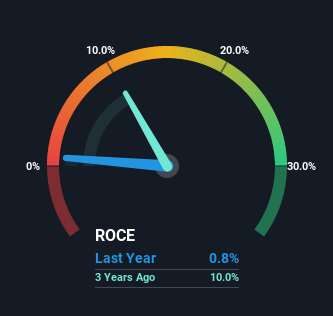- France
- /
- Consumer Durables
- /
- ENXTPA:ALHEX
Hexaom's (EPA:ALHEX) Returns On Capital Tell Us There Is Reason To Feel Uneasy

What underlying fundamental trends can indicate that a company might be in decline? When we see a declining return on capital employed (ROCE) in conjunction with a declining base of capital employed, that's often how a mature business shows signs of aging. This indicates to us that the business is not only shrinking the size of its net assets, but its returns are falling as well. So after we looked into Hexaom (EPA:ALHEX), the trends above didn't look too great.
What Is Return On Capital Employed (ROCE)?
Just to clarify if you're unsure, ROCE is a metric for evaluating how much pre-tax income (in percentage terms) a company earns on the capital invested in its business. Analysts use this formula to calculate it for Hexaom:
Return on Capital Employed = Earnings Before Interest and Tax (EBIT) ÷ (Total Assets - Current Liabilities)
0.0076 = €1.9m ÷ (€739m - €483m) (Based on the trailing twelve months to December 2022).
Thus, Hexaom has an ROCE of 0.8%. Ultimately, that's a low return and it under-performs the Consumer Durables industry average of 18%.
Check out our latest analysis for Hexaom

Above you can see how the current ROCE for Hexaom compares to its prior returns on capital, but there's only so much you can tell from the past. If you'd like, you can check out the forecasts from the analysts covering Hexaom here for free.
SWOT Analysis for Hexaom
- Cash in surplus of total debt.
- Dividend is in the top 25% of dividend payers in the market.
- Interest payments on debt are not well covered.
- Expected to breakeven next year.
- Has sufficient cash runway for more than 3 years based on current free cash flows.
- Good value based on P/S ratio and estimated fair value.
- Debt is not well covered by operating cash flow.
- Dividends are not covered by cash flow.
What The Trend Of ROCE Can Tell Us
There is reason to be cautious about Hexaom, given the returns are trending downwards. To be more specific, the ROCE was 18% five years ago, but since then it has dropped noticeably. And on the capital employed front, the business is utilizing roughly the same amount of capital as it was back then. This combination can be indicative of a mature business that still has areas to deploy capital, but the returns received aren't as high due potentially to new competition or smaller margins. If these trends continue, we wouldn't expect Hexaom to turn into a multi-bagger.
While on the subject, we noticed that the ratio of current liabilities to total assets has risen to 65%, which has impacted the ROCE. If current liabilities hadn't increased as much as they did, the ROCE could actually be even lower. And with current liabilities at these levels, suppliers or short-term creditors are effectively funding a large part of the business, which can introduce some risks.
Our Take On Hexaom's ROCE
In the end, the trend of lower returns on the same amount of capital isn't typically an indication that we're looking at a growth stock. Investors haven't taken kindly to these developments, since the stock has declined 63% from where it was five years ago. Unless there is a shift to a more positive trajectory in these metrics, we would look elsewhere.
Hexaom does have some risks though, and we've spotted 1 warning sign for Hexaom that you might be interested in.
If you want to search for solid companies with great earnings, check out this free list of companies with good balance sheets and impressive returns on equity.
Valuation is complex, but we're here to simplify it.
Discover if Hexaom might be undervalued or overvalued with our detailed analysis, featuring fair value estimates, potential risks, dividends, insider trades, and its financial condition.
Access Free AnalysisHave feedback on this article? Concerned about the content? Get in touch with us directly. Alternatively, email editorial-team (at) simplywallst.com.
This article by Simply Wall St is general in nature. We provide commentary based on historical data and analyst forecasts only using an unbiased methodology and our articles are not intended to be financial advice. It does not constitute a recommendation to buy or sell any stock, and does not take account of your objectives, or your financial situation. We aim to bring you long-term focused analysis driven by fundamental data. Note that our analysis may not factor in the latest price-sensitive company announcements or qualitative material. Simply Wall St has no position in any stocks mentioned.
About ENXTPA:ALHEX
Flawless balance sheet and good value.
Market Insights
Community Narratives




